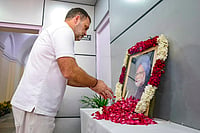For large numbers of Bangladeshi and Rohingiya women, its a journey to hell. A journey that begins from home - the borders of lower Myanmar and Bangladesh - and culminates in the festering ghettos of Karachi and other Pakistani cities. In officialese this is subcontinental illegal human trafficking, although calling it plain slave trade would be a better description. Once in Pakistan, the price of a female illegal migrant ranges from $1,285 to $2,428, depending on her physical attributes and conditioning. Harassed, tortured, exploited and abused every step of the longest refugee trail in Asia, only the lucky ones die young.
At least the women from Bangladesh enjoy a slight advantage in that they possess a national identity. It is the Rohingiya women who are truly rootless - rejected by their native Myanmar, illegal migrants in Bangladesh, India or Pakistan, their stateless status renders them fair game for every pimp, tout, police informer and border guard across the subcontinent, not to mention the agents who run this flesh trade.
The Rohingiyas of the Arakan province of Myanmar are conservative Muslims in religion whose customs and rituals resemble those of Bangladeshis settled in the areas bordering Myanmar. Their first recorded settlements in Burma go back several centuries. When the British took over Burma in 1784, there was no ethnic tension. But relations between the primarily Buddhist ruling Burmese elite and the Rohingiyas were always strained. The change of guard in Burma in 1962, when the army took over, rendered these people more vulnerable, in that not even the figleaf of a democratic safeguard or human rights considerations now remained.
Ironically, in Arakan, both the ruling slorc military junta and their opponents, protagonists for greater Arakanese autonomy, are hostile towards the Rohingiyas. It is alleged that Islamic fundamentalists, aided by the Saudi Arabian ngo-cum-religious organisation Rabita, use them for local conversions. In 1962 and 1978, after they were attacked by the Burmese troops and frequently by the Rakhines (Buddhist Arakanese) as well, there were mass Rohingiya migrations to Bangladesh. In 1982, an amendment in citizenship laws robbed them of even minimum rights and by 1992, ethnic cleansing operations had forced around 250,000 Rohingiyas to escape to Bangladesh - where they mostly settled in shantytowns in Coxs Bazaar, Chittagong.
Sajda, a 19-year-old Rohingiya girl, in an interview to the social welfare-oriented Image Asia group last March, related her experience of life in Myanmar: "Rape is very common. Women are too scared to leave their homes. The military kidnapped girls and took them to their camps. They were released only after being gangraped. Women arent safe even in their houses." Says Rahima, a widow with two sons in Pakistan, "The army took my husband as a porter and gave him no food for two weeks. Starvation and the beatings he was subjected to killed him. Other porters brought his body. I cleaned houses for a living. The government took away everything, our land, house, to give to the Rakhines, saying, you are not our people, go away."
Estimates about the size of Rohingiya influx into the neighbouring countries vary, but agencies like ubinig (a Bangladesh ngo) and the unhcr agree that out of nearly 200,000 illegal Bangladeshi women believed to be now living in Karachi alone, at least 20,000 are Rohingiyas. Most deny their origin, perhaps to escape the stigma of being homeless, and claim to be Bangladeshis. But that doesnt alter their living conditions and most are forced to work as ragpickers, casual labourers and sex workers.
Official indifference to such illegal human trafficking, from Myanmar to Pakistan, hasnt just sealed the fate of these unfortunate women but has directly helped those who benefit from it - supplying agents and touts, border guards, policemen and greasy-fingered officials. Myanmar authorities refuse to accept Rohingiyas as bona fide citizens. In general, the behaviour of Bangladeshi authorities is marginally better. "They allow us to pass through their area, provided we do not stay on," says one woman. However, others complained of pressure from Bangladeshi authorities who apparently stopped food supplies and also adopted other means to make sure they returned to Myanmar. On return they were promptly evicted again.
The fact of the Rohingiyas being denied their land and their cycle of enforced migration isnt something that leaves India unaffected. The Rohingiyas are forced to enter India through the porous borders of West Bengal, where the political leadership and the administration is only too happy to admit refugee minorities from Bangladesh or Myanmar after making sure that the right persons are bribed and that the newcomers pledge their support to the right political party. The passage through India to Pakistan may take anything from a week to a month, depending on the luck of the migrants and the strength of their agents political connections. Mostly, Rohingiya and Bangladeshi women enter through Bongaon and other checkpoints on the Indo-Bangla border, reaching Calcutta, which is a major transit point, en route to Pakistan. Many, however, have settled in West Bengal itself, working as domestic helps and living in shanties near railway stations.
The women have found some backing from the Left parties although such support comes with strings attached. "At every step the women are vulnerable to the local area bosses, panchayat leaders and the police, who have to be bribed regularly and who think nothing of extracting other favours from these women who cannot approach officials for fear of detection and deportation," explains an ngo spokesman.
For the Bangladeshis, it is always possible to make periodic trips back home to meet relatives or to send money. But the Rohingiyas "cannot dream of such luxuries," says a ubinig spokesman. "Even when pushed back from Bangladesh, they cannot return home simply because Myanmar doesnt accept them as citizens. Either they are again pushed out or simply worked to death in labour camps where they dont exist even as statistical details." The agony does not end after migrating out and there have been instances of Rohingiyas also being jailed both in India and Bangladesh.
For these women theres absolutely no deliverance at hand. Consigned to a rootless fate, with barely any connections in the alien societies they are forced to live in, their agents and touts wield the power of life and death over them. Being violently erased from their land isnt all, these people also face a destruction of their basic cultural identity. Therere many instances of Rohingiya women forgetting their mother tongue after years of stay in Pakistan. Young Bangladeshi girls may dimly remember their parents, perhaps even vaguely recognise them, but cant speak to them. They earn only a pittance and have to unquestioningly shell out bribes for the sake of living a miserable life in the filthiest surroundings, doing the most demeaning of jobs without any medical help or education.
Ironically, for most of them, even hell is better than suffering in their own country. It appears that in Pakistan or India, even in conditions of utter degradation, one can still earn enough to keep body and soul together. "Back home, there is no source of income, no money and frequent starvation is a way of life. In Myanmar, living standards in the border areas are worse than conditions even in Bangladesh," says Hanifa, a Rohingiya woman from Myanmar, echoing the sentiments Bangladeshis advance as an explanation for their illegal migration to India or Pakistan. And for the host countries, these people are an unending source of cheap labour. They would never dare challenge their exploitation. Its a brutal, vicious cycle of dehumanisation. And theres no end in sight.





















